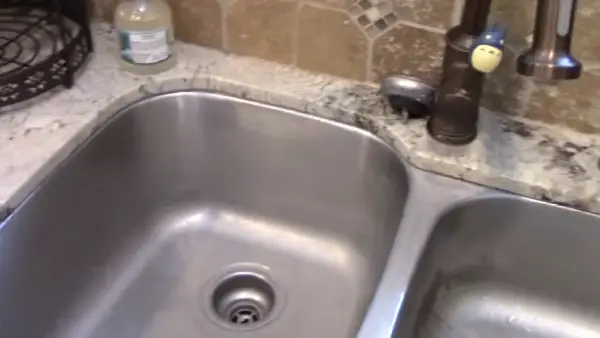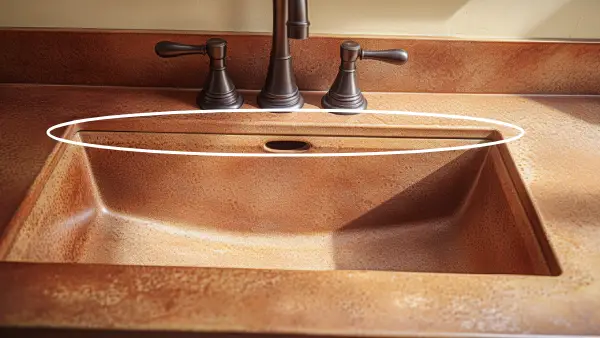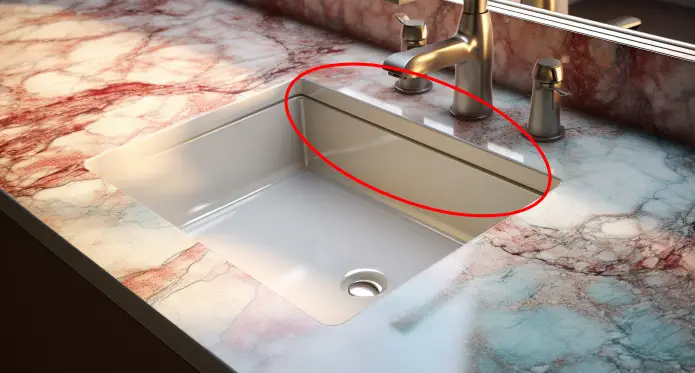Last Updated on November 9, 2023
Your kitchen’s under-mount sink may be a sleek and modern addition to your home, but mold can grow in it and make it unsightly. Mold problems under undermount kitchen sinks can cause concern to the hygienic environment, and understanding the reasons behind them can help prevent them.
One of the main culprits behind under-mount sink mold problems is moisture accumulation caused by plumbing leaks, unnoticed drips, or even humidity.
When water enters hidden corners or collects beneath the sink, it creates the perfect breeding ground for mold.
Inadequate ventilation within the cabinet under your sink can exacerbate this issue, trapping moisture and encouraging mold spores to settle and thrive.
We’ll explore the causes and effective solutions for under-mount sink mold, ensuring your kitchen remains healthy and clean.
What Are the Causes of Mold Issues in Undermount Kitchen Sinks?

Mold issues in under-mount kitchen sinks can be caused by several factors.
- Moisture accumulation and inadequate ventilation
- Organic materials
- Warm temperatures
- Poor sealing and caulking
Check out the under-mount sink mold problems and solutions in detail now.
1. Moisture Accumulation and Inadequate Ventilation
Excess moisture is the primary culprit behind mold growth, and it can come from various sources, such as leaky pipes, spills, or high humidity levels in the kitchen.
When water accumulates in hidden corners or beneath the under-mount sink, it creates an ideal environment for mold to thrive.
However, poor ventilation in the cabinet under the sink can trap moisture and prevent it from drying out. This stagnant air encourages mold spores to settle and grow.
2. Organic Materials
The most common materials found under kitchen sinks, such as wood, drywall, and cardboard, are highly susceptible to mold infestation.
Mold spores can easily settle on these materials and start to consume them, leading to the growth and spread of mold.
3. Warm Temperatures
If the temperature in your kitchen remains warm, it can contribute to the growth of mold in your under-mount sink. Mold thrives in warm and moist environments, making your kitchen a perfect breeding ground.
The warmth allows mold spores to multiply rapidly, while moisture provides them with the necessary conditions for growth.
4. Poor Sealing and Caulking
In under-mount sinks, improper sealing or caulking between the sink and the countertop can allow water to seep into the crevices. This water can remain hidden, encouraging mold growth over time.
How to Clean a Molded Area in Undermount Kitchen Sinks?
To clean a molded area in your under-mount kitchen sink, do the following:
Step 1: Prepare Yourself and Remove Items
In the beginning, put on your breathing mask, eye protection, and rubber gloves, and remove all items from under the sink.
Once you have taken the necessary precautions, proceed to empty the area completely. This includes removing any cleaning supplies, pipes, or other items that may be stored there.
Step 2: Apply Cleaning Solution
After that, generously apply the cleaning solution to the molded area, ensuring a thorough coverage.
You can make a potent cleaning solution using mold-specific cleaners or natural ingredients like vinegar, tea tree oil, and grapefruit seed extract.
Make sure you apply the solution generously to ensure that all mold growth is targeted. Also, make sure to cover every nook and cranny of the affected area, paying close attention to corners and crevices.
Step 3: Let It Sit
Now, allow the cleaning solution to sit on the molded area for at least an hour, ensuring the mold is effectively broken down.
Letting the cleaning solution sit gives it enough time to penetrate and dissolve the mold, making it easier to remove.
Step 4: Scrub
Then, take a soft sponge or brush and scrub the moldy area using a back-and-forth motion. By physically removing the mold, you prevent it from spreading further and causing potential health risks.
Be gentle while scrubbing to avoid damaging the surface of your sink. Pay extra attention to any hard-to-reach corners or crevices where mold accumulates.
Step 5: Rinse
Once you have finished scrubbing the moldy area, thoroughly rinse it with clean water to remove all soap residue.
Make sure to reach all the nooks and crannies, as mold can easily hide in hard-to-reach places. Pay special attention to any visible mold spores or stains, as they may require extra rinsing.
Repeat the rinsing process until the water runs clear and no soap traces are left. After rinsing, allow the area to air dry completely.
How to Prevent Mold Growth in Your Undermount Kitchen Sink?

Preventing spore growth under your under-mount kitchen sink involves proactive measures to keep the area dry and inhospitable to mold:
1. Regular Inspection and Plumbing Maintenance
Make sure to thoroughly inspect your under-mount kitchen sink at least once a month to prevent mold growth and address any potential issues.
Start by checking for any signs of water damage or leaks in the cabinet under the sink. Look for wet spots, discoloration, or a musty smell, as these can indicate mold growth.
Check the pipes and connections for any leaks or loose fittings. Inspect the sink itself for any cracks or damage that could lead to water leakage.
Additionally, examine the caulking around the edges of the sink to ensure it’s intact and in good condition. If you do find any issues, take immediate action to fix them and prevent further damage.
2. Install a Water Alarm
You should consider installing a water alarm under your kitchen sink because it can help you quickly detect leaks and take immediate action.
3. Waterproof Lining
Consider applying a waterproof lining to your undermount sink cabinet right now to prevent mold growth in the future.
By adding a waterproof lining, you create a barrier that prevents water from reaching the cabinet’s surface, effectively reducing the chances of mold growth.
4. Mold-Resistant Paint
If you want to protect your under-mount kitchen sink from mold growth, apply mold-resistant paint to the cabinet area.
Mold-resistant paint contains additives that inhibit the growth of mold and mildew, preventing them from taking hold of the surface of the cabinets.
5. Humidity Control
Maintain indoor humidity levels below 40% to reduce the likelihood of mold occurrence in your kitchen.
To control humidity, you can invest in a good quality dehumidifier for your home. You can also use exhaust fans while cooking or running the dishwasher to remove excess moisture from the air.
How long does it take for mold to grow undermount kitchen sink?
The time it takes for mold to grow under an undermount kitchen sink can vary depending on several factors. Moisture, suitable surfaces, temperature, and mold spore presence influence mold growth.
In some cases, mold can start to develop within 24 to 48 hours if there is a continuous source of moisture, such as a persistent plumbing leak. However, it may take longer, several days to a few weeks, for visible mold colonies to become apparent.
How often should you clean the undermount sink area to prevent mold growth?
Cleaning the under-mount sink area regularly is crucial for preventing mold growth. As part of your routine cleaning schedule, it’s recommended to clean the space every 1-2 weeks to prevent mold growth.
However, the frequency may vary depending on the local climate, humidity levels in your home, and how often the sink is used.
If you reside in a particularly humid area, cleaning the area more frequently, possibly every week, is advisable to stay ahead of mold growth.
Embrace a Healthy Kitchen: Bid Adieu to Mold
Understanding the causes of mold growth under your under-mount kitchen sink and implementing effective solutions are your best strategies.
Excess moisture, inadequate ventilation, organic materials, and temperature all play pivotal roles in mold growth. But, with regular inspection, proper maintenance, and proactive prevention, you can keep your kitchen clean and healthy.
As a result, follow the cleaning steps and prevention instructions outlined above to eliminate mold and make it difficult for it to grow in the future.Your undermount sink can remain sleek and modern, free from the unsightly presence of mold, ensuring a more hygienic kitchen for you and your family.

